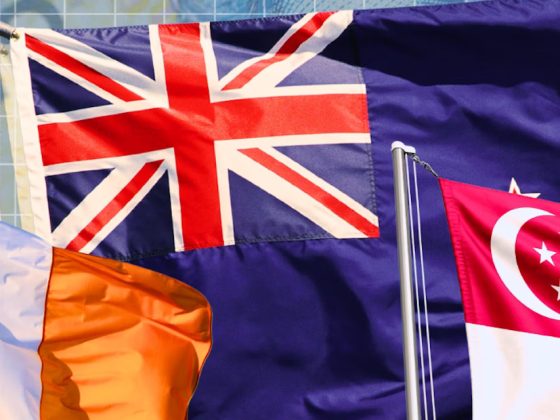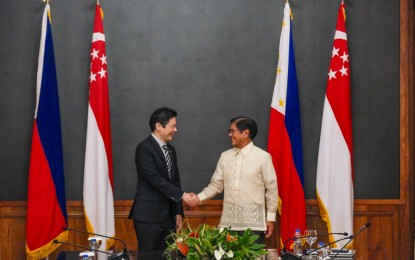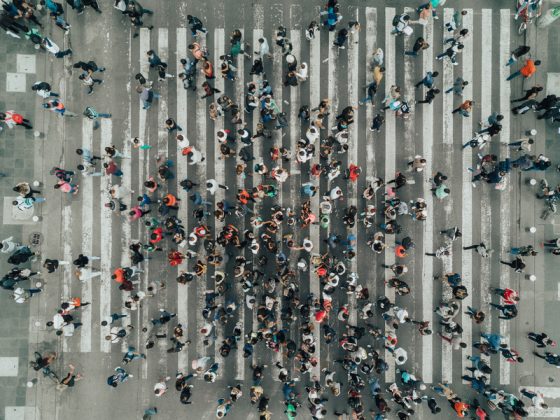An Anaerobic Digestion system for food waste treatment is being piloted at the East Coast Lagoon Food Village. The system was developed by a team of researchers from the National University of Singapore (NUS) and converts food waste generated by food stalls and patrons at East Coast Lagoon Food Village into biogas and bio-fertiliser. A biogas engine converts the biogas into electricity, while the bio-fertiliser is used in landscaping applications. The onsite treatment of food waste reduces the need to send food waste for incineration.
Food waste is one of the priority waste streams identified under Singapore’s Zero Waste Masterplan. In 2020, food waste accounted for about 11 per cent of the total waste generated in Singapore, but only 19 per cent of the food waste was recycled. The rest of it was disposed of at waste-to-energy (WTE) plants. Therefore, reducing food wastage, redistributing unsold or excess food, and recycling/treating food waste are important food waste management strategies. Food waste needs to be managed holistically, as it can contaminate other recyclables when they are disposed of together, making the recyclables unsuitable or difficult to recycle. It can also give rise to odour nuisance and vermin proliferation issues, if not managed properly or in a timely manner.
As part of efforts to treat food waste and demonstrate the feasibility of on-site food waste treatment, the National Environment Agency (NEA) is supporting NUS in conducting a pilot trial of their containerised Anaerobic Digestion system at East Coast Lagoon Food Village, under the Closing the Waste Loop (CTWL) R&D Initiative. The NUS team, led by Associate Professor Tong Yen Wah from the NUS Department of Chemical and Biomolecular Engineering, oversees the operation and maintenance of the Anaerobic Digestion system. The team is concurrently studying the human psychology and behavioural factors in encouraging hawkers and cleaners to segregate food waste from other waste.
Assoc Prof Tong from NUS, explained, “Our NUS team is excited to be leading this effort, with support from NEA and NParks, to reduce waste in Singapore and turn food scraps into a green energy resource. Our technology is unique because it is easy to operate, and can now generate heat, fertiliser and electricity for areas at or around the hawker centre. When coupled with the human behavioural studies, our system is no longer just mere technology, but a component of social change that will help to ensure the success of an on-site system to close the food waste loop at its source.”
NEA and NParks have signed a Memorandum of Understanding to collaborate on this pilot project. NParks will study the use of the digestate produced from the Anaerobic Digestion process (i.e. liquid residues from the biodegradation of food waste) for landscaping application at East Coast Park, thereby closing the food waste loop there.
Mr Chia Seng Jiang, Group Director for Parks East at NParks, said, “We are happy to collaborate on this pilot project with NEA and NUS to support efforts to convert food waste into energy and fertiliser at East Coast Park. NParks is working closely with NUS researchers on the experimental design of this project and practical applications of the digestate. We are identifying pilot sites at East Coast Park to test the efficacy of the digestate as fertiliser.”
How Anaerobic Digestion of Food Waste Works
The Anaerobic Digestion system takes in source segregated digestible food waste, such as fruits and vegetable trimmings, preparation scraps from the stalls and leftover table waste. Microbes then feed on the blended food waste to produce methane-rich biogas and nutrient-rich digestate. Biogas is used to run a gas engine to generate electricity, while the digestate could be used as fertilisers for ornamental plants and landscaping applications. More details on the AD system can be found in Annex A.
Patrick Pang, Chief Technology Officer at NEA, said, “Innovations such as onsite anaerobic digestion make it possible to create useful products from food waste, which would otherwise have to be sent for incineration. Such technologies help to reduce the environmental footprint of managing food waste and contribute to a circular economy.”
East Coast Lagoon Food Village Anaerobic Digestion Pilot
East Coast Lagoon Food Village was chosen for the pilot trial as adjacent space was available to house the Anaerobic Digestion system and the bio-fertilisers could conveniently be applied at the nearby East Coast Park. There are about 60 occupied stalls there that together generate about 150 kg of digestible food waste daily. The Anaerobic Digestion system is designed to handle this load. The pilot project serves to gather longer term, real-world data while showcasing that a customised Anaerobic Digestion system at the food village is feasible and practical.
Anaerobic Digestion is an established technology that has been adopted in some countries. It is mainly implemented at offsite or centralised facilities where food waste is aggregated from neighbouring premises. This pilot project, however, examines the feasibility of using Anaerobic Digestion as an on-site treatment solution to close the food waste loop at the source of food waste generation. In addition, this project integrates sub-systems such as a waste bin loader, sorter, shredder and feeder, to enhance the Anaerobic Digestion system’s performance. This will automate the loading of food waste and minimise contamination of food waste fed into the Anaerobic Digestion system. The exact location of the Anaerobic Digestion system at East Coast Lagoon Food Village can be found in Annex B.
The biogas produced from the Anaerobic Digestion process is converted into electricity to power the system itself and two mobile phone charging stations for the public’s use. In addition, the excess electricity can also power up to 31 wall-mounted fans at East Coast Lagoon Food Village. As for the digestate, NUS is working with NParks to study its efficacy for growing ornamental plants and turn it into pathogen-free fertilisers for NParks’ landscaping application around East Coast Park.
The concrete base that supports the Anaerobic Digestion system is made from NEWSand (the slag that is a by-product from the slagging gasification of general waste), which if more broadly adopted, will help to reduce waste sent to Semakau Landfill.
Covered bins have been provided to the stallholders and table cleaners to aid in the segregation of food waste. The food waste is then emptied into five smart bins (refer to Annex C) placed around East Coast Lagoon Food Village, which record and store data on the amount of segregated food waste from each of these users.
Waste Reduction as a Whole-of-Nation Effort
This pilot project is unique in its human behavioural study as a complement to the technologies deployed. NEA and NUS will actively engage the stakeholders involved, from hawkers to diners, to raise awareness on the importance of food waste segregation for recycling and the derived sustainability benefits. This includes posters and wall stickers (refer to Annex D for examples of collaterals) to remind diners to return their trays and used crockery and encourage stallholders and cleaners to proactively segregate food waste from other waste.
~~ End ~~
For more information, please submit your enquiries electronically via the Online Feedback Form or myENV mobile application. Alternatively, you contact us at 6225 5632.
ANNEX A
Process Diagram of Anaerobic Digestion of Food Waste

ANNEX B
Location of Anaerobic Digestion of Food Waste Pilot

ANNEX C
Uses of food waste converted from the AD system, as well as tools and materials provided to stallholders and cleaners
 |
 |
| Bins provided to stallholders | Bins provided to cleaners |
 |
 |
| Acceptable and non-acceptable food items | Smart bins |
 |
 |
| Mobile charging stations for the public | Wall-mounted fan powered by the AD system |
ANNEX D
Education Collaterals
|
|
|
|
Posters |
Table stickers |












